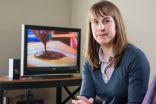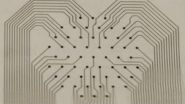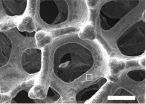By land and by sea: Scientists find differences in tanning treatments for materials
2015-03-17
(Press-News.org) Cod liver oil and willow bark extract used in the tanning of skins for clothing and other products offer notable differences in treatment, a study by a team of scientists shows. Their findings show the promise of a technique that may be used to identify the aging behavior of materials and to examine delicate works of art.
The research, which appears in the journal Analytical Chemistry, relies on a method employing nuclear magnetic resonance spectroscopy, or NMR spectroscopy, which reveals the physical and chemical properties of atoms in a given substance, as well as the more commonly known magnetic resonance imaging (MRI).
"Because this is a non-invasive method, it can be used to examine and evaluate the most fragile of materials without damaging them," explains Alexej Jerschow, a professor in NYU's Department of Chemistry and one of the study's co-authors.
"As well as offering insight into the material qualities and the preservation state of an artifact, the results provide a more complete picture of the variation of properties across the samples and give critical insight into the mechanisms of the material deterioration," adds co-author Torunn Klokkernes, head of Collection Management at the University of Oslo's Museum of Cultural History.
"Historically, the treatment of skin-based clothing has varied among different cultures," explains co-author Eleonora Del Federico, professor of chemistry at the Pratt Institute. "Therefore, the NMR technique, in principle, could aid researchers in determining a specific tanning technique, but also provide insight into the provenance of a particular artifact."
The team employed NMR spectroscopy and MRI to evaluate two skin-tanning methods on samples of various ages: one using cod liver oil and the other employing a willow bark extract commonly used in tanning. These two methods were compared with an untreated skin.
They found that skin samples treated using the two tanning methods could be differentiated by their relaxation properties--similar to the way healthy tissue is distinguished from diseased tissue in clinical MRI scans. Changes in the chemistry of the skin samples could also be detected, giving insight into the changes brought about by the tanning processes. All of this information could be acquired without damaging the samples, making it a promising approach for the study of other, historically important artifacts.
INFORMATION:
The study's other authors included Cindie Kehlet, an assistant professor chemistry at the Pratt Institute, as well as NYU graduate student Lizheng Zhu and postdoctoral fellow Andrew Ilott.
The study was supported, in part, by funding from the National Science Foundation (1412064) as well as the Alfred P. Sloan Foundation and the Henry and Camille Dreyfus Foundation.
ELSE PRESS RELEASES FROM THIS DATE:
2015-03-17
A research team led by Northwestern University nanomedicine expert Chad A. Mirkin and Sergei Gryaznov of AuraSense Therapeutics is the first to show spherical nucleic acids (SNAs) can be used as potent drugs to effectively train the immune system to fight disease, by either boosting or dampening the immune response. The initial treatment triggers a cell-specific immune response all over the body.
By increasing the body's immune response toward a specific cell type, SNAs could be used to target anything from influenza to different forms of cancer. They also can be used ...
2015-03-17
New heart imaging technology to diagnose coronary heart disease and other heart disorders is significantly more accurate, less expensive and safer than traditional methods, according to a new study by researchers from the Intermountain Medical Center Heart Institute in Salt Lake City.
Researchers at the Intermountain Medical Center Heart Institute compared Single Photon Emission Computed Tomography (SPECT), currently the most commonly used imaging diagnostic tool, with a new imaging technology -- coronary-specific Positron Emission Tomography (cardiac PET/CT).
They ...
2015-03-17
A recently published global genome study that used the data-intensive Gordon supercomputer at the San Diego Supercomputer at the University of California, San Diego, has researchers rethinking how avian lineages diverged after the extinction of the dinosaurs.
The four-year project, called the Avian Genome Consortium and published in the journal Science, resulted in a new family "tree" for nearly all of the 10,000 species of birds alive today by comparing the entire DNA codes (genomes) of 48 species as varied as parrot, penguin, downy woodpecker, and Anna's hummingbird. ...
2015-03-17
SAN DIEGO (March 16, 2015) -- Patients who experience the deadliest form of heart attack--ST segment elevation myocardial infarction (STEMI)--and suffer from substantial narrowing in multiple heart arteries may benefit from receiving angioplasty in constricted arteries not affected by the heart attack, thereby reducing the need for future angioplasty, according to research presented at the American College of Cardiology's 64th Annual Scientific Session.
The study is the largest prospective, controlled trial to evaluate whether patients should receive preventive angioplasty, ...
2015-03-17
OAKLAND, Calif. -- Specific system-level factors controlled by health care systems - including prescriptions with a medication supply greater than 90 days, mail-order pharmacy use, and lower copayments and out-of-pocket maximums - nearly doubled the likelihood that patients adhered to prescribed heart and diabetes medications, according to a new study published in the journal Medical Care.
"This study is the first to look at all four of these system-level factors at once in the senior population," said Julie A. Schmittdiel, PhD, research scientist with the Kaiser Permanente ...
2015-03-17
If you're a fan of food television, it's fine to be entertained by the programming, but if you take recipes for the rich meals the networks favor into your own kitchen, you're at risk of putting on pounds, according to a study just published online by the journal Appetite.
"The message is clear," said Lizzy Pope of the University of Vermont, the study's lead author. "Food TV should be a viewing experience only, not a cooking experience."
The study asked 501 women, aged 20 to 35, where they obtained information about new foods, how frequently they cooked from scratch, ...
2015-03-17
Healthy bone is continuously involved in a dynamic process that includes bone deposition and bone resorption. However, when a person has cancer that spreads to the bone and bone marrow, the tissue becomes increasingly fragile, and this process is disrupted, usually leading to increased bone resorption.
In an early online edition in advance of publication in the International Journal of Cancer, investigators at Children's Hospital Los Angeles reported a surprising discovery - when neuroblastoma (NB) cells metastasize to the bone, there initially occurs an increase in bone ...
2015-03-17
Berkeley -- Engineers at the University of California, Berkeley, are developing a new type of bandage that does far more than stanch the bleeding from a paper cut or scraped knee. Thanks to advances in flexible electronics, the researchers, in collaboration with colleagues at UC San Francisco, have created a new "smart bandage" that uses electrical currents to detect early tissue damage from pressure ulcers, or bedsores, before they can be seen by human eyes - and while recovery is still possible.
"We set out to create a type of bandage that could detect bedsores as ...
2015-03-17
UNSW Australia scientists have developed a highly efficient oxygen-producing electrode for splitting water that has the potential to be scaled up for industrial production of the clean energy fuel, hydrogen. The new technology is based on an inexpensive, specially coated foam material that lets the bubbles of oxygen escape quickly.
"Our electrode is the most efficient oxygen-producing electrode in alkaline electrolytes reported to date, to the best of our knowledge," says Associate Professor Chuan Zhao, of the UNSW School of Chemistry.
"It is inexpensive, sturdy and simple ...
2015-03-17
Tuesday, March 17, 2015. Just like milk and many other foods, blood used for transfusions is perishable. But contrary to popular belief, new research shows that blood stored for three weeks is just as good as fresh blood - findings published today in the New England Journal of Medicine.
The large clinical trial provides reassuring evidence about the safety of blood routinely transfused to critically ill patients. Supported by the Canadian Critical Care Trials Group and countless nurses, blood bank technologists, transfusion medicine and critical care physicians, Drs. ...
LAST 30 PRESS RELEASES:
[Press-News.org] By land and by sea: Scientists find differences in tanning treatments for materials


